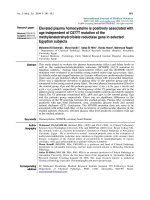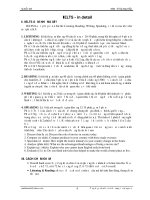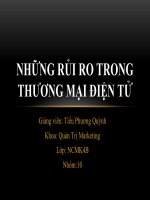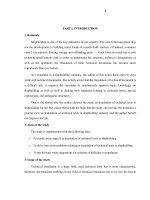ABDEEN PALACE IN CAIIRO, EGYPT
Bạn đang xem bản rút gọn của tài liệu. Xem và tải ngay bản đầy đủ của tài liệu tại đây (4.72 MB, 42 trang )
Click to continue
after each slide
Abdeen palace is considered the jewel of the 19th century architecture in Cairo.
When Khedive Ismail Pasha - grand' son of Mohamed Ali - came to power in 1863,
Egypt was engaged already in the building of the Suez Canal which was due to open in
1869. For this occasion, Egypt was supposed to receive dignitaries from different
countries of the world and Khedive estimated that Cairo with its 10th century Fatimid
capital was not ready to accommodate such event. He bought the small palace of
Abdeen Bey, a member of the Mamlouk corps, along with its surroundings, demolished
it and used the whole area to build the Abdeen palace we know today.
The palace was designed in a Neo-Classical French
inspired style. The chief architect that supervised the
construction was the French architect Leon Rousseau.
The palace was composed of two floors. The upper floor
contained both the Salamlek (the main quarter) and the
Haramlek (Family quarter), which contradicted the old
tradition of separating them in different buildings. The
ground floor was dedicated to the different services such
as guards quarters, storerooms etc
Abdeen palace witnessed the succession of the
Egyptian rulers starting with Khedive Ismail followed by
Khedive Tewfik, then Khedive Abbas Helmi II, Sultan
Hussein Kamel, King Fouad and finally King Farouk.
During every reign, the palace had witnessed important
events
Khedive Ismaïl Pacha
The palace has several entrances. This is the most important. It is located in the
centre of the eastern wall of the palace. It was intently constructed for the entrance
of Empress Eugenie of France , wife of Emperor Napoleon III, during the Suez
Canal opening ceremony on November 17, 1869. The palace was opened 3 years
after the ceremony
The Gate of Paris
Inside the palace, the Red sitting-room for official delegations
The Green sitting-room
The
sitting-
room of
the
house
The
Byzantine
Hall
(Part 1)
Used to
receive
the guests
before
entering
the dance
room
The
Byzantine
Hall
(Part 2)
The
Throne
Hall
Where the
coronation
of the king
takes
place
In 1938, during the reign of King Farouk, the Palace witnessed his fairy
wedding to queen Farida in the Throne hall. In the same year, the palace
hosted the Royal wedding of princess Fawzia, sister of king Farouk, to the
Iranian crown prince Mohamed Reza Pahlavi.
Wedding ceremony of
Princess Fawzia, to the
Crown Prince of Iran, the
future Shah
King Farouk, Queen Farida
and Princes Ferjal
Wedding of Farida with
King Farouk
The Theatre
The
Mohamed
Ali Hall
Next to the
theatre.
Reception of the
guests before
entering the
theatre
.
Corridor
to the
Mohamed
Ali Hall
The Theatre
Contains hundreds
of seats painted in
gold and sitting
rooms for women
with red curtains
on the side
The
Belgian
Pavilion
(View 1)
Devoted to
the
establishment
of guests of
Egyptian
rulers.
The
Belgian
Pavilion
(View 2)
King’s mother Pavilion (View 1)
Was the room of Queen Nazli, mother of King Farouk
King’s mother Pavilion (View 2)
Office of the President (View 1)
Located in the hall of the Suez Canal, which has been prepared to
commemorate the digging of the Suez Canal. It is decorated with
three pictures of the excavation and construction of the canal.
Office of
the
President
(View 2)
Office of
the
President
(View 3)
Office of the President (View 4)
The Library
Contains more than 44.500
books.
A collection of rare books
and a set of international
books belonging to the royal
family.
The
Gardens
(View 1)
Spread over
20 acres
planted with
citrus and
flowers
The Gardens (View 2) The Tea Kiosk
“koshk el shay” as they used to call it.
The Royal family had the afternoon tea often in this place.
The
Gardens
(View 3)
The
Music
Kiosk









